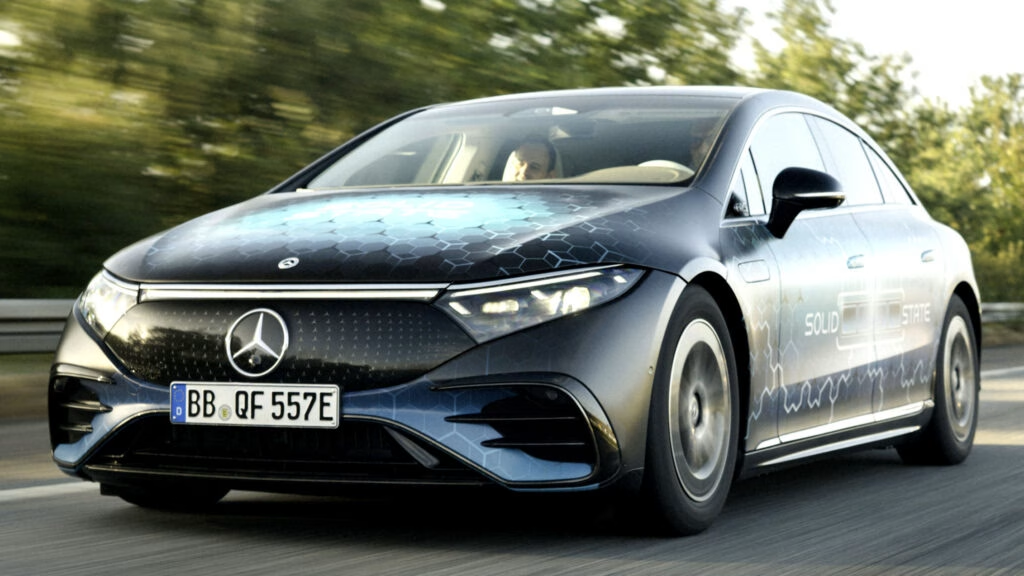How Did Mercedes-Benz Push the Boundaries of EV Range With Solid-State Batteries?
Imagine driving from Stuttgart, Germany, to Malmö, Sweden—crossing borders, passing through Denmark, and never once stopping to plug in your electric car. That’s exactly what Mercedes-Benz achieved with its latest EQS prototype, clocking an astonishing 748.8 miles (1,205 km) on a single charge. And here’s the kicker: when the journey ended, there was still an estimated 85 miles (137 km) left in the battery. That’s enough to keep going well past the city limits, maybe even to the next country over.
This isn’t just a headline-grabbing stunt. It’s a real-world demonstration of what’s possible when you pair cutting-edge engineering with a new generation of batteries. The EQS prototype’s secret weapon? A solid-state battery pack that’s rewriting the rules for electric vehicles.
What Makes Solid-State Batteries Such a Gamechanger for Electric Cars?
For years, solid-state batteries have been the stuff of EV dreams. They promise higher energy density, faster charging, and better safety compared to traditional lithium-ion packs. But getting them out of the lab and into the real world has been a slow burn. Mercedes-Benz, working alongside Mercedes-AMG High Performance Powertrains and its Formula 1 tech center in the UK, has finally taken a big step forward. Their prototype uses lithium-metal cells developed with Factorial Energy, a U.S.-based leader in the field.
Here’s what’s remarkable: the new solid-state pack delivers 25 percent more energy than the standard EQS battery, yet it doesn’t add any extra weight or bulk. In the world of EVs, where every kilogram counts, that’s a massive leap. More energy with the same footprint means longer range without sacrificing performance or interior space.
How Does This Compare to Other Long-Range Electric Vehicles?
You might remember the Lucid Air Grand Touring, which recently set a Guinness World Record by driving the same 748.8 miles on a single charge. The difference? Lucid did it with a conventional 117 kWh lithium-ion battery, while Mercedes-Benz matched the feat using a solid-state pack—and still had juice to spare.
This isn’t just about bragging rights. It’s proof that solid-state technology can deliver on its promise, not just in controlled lab conditions but out on the open road. And if Mercedes had pushed the prototype to its limit, estimates suggest it could have reached 834 miles (1,342 km) before running out of power. That’s well beyond what any current production EV can manage.
What’s the Real-World Impact for Drivers?
Let’s get practical. For most people, range anxiety is the number one reason they hesitate to go electric. The idea of running out of power far from a charging station is unnerving, especially on long road trips. But with a solid-state battery capable of 800-plus miles, that worry starts to look a little outdated.
Plus, solid-state batteries have other perks. They’re less prone to overheating, offer faster charging, and are generally safer in the event of a crash. According to a 2023 report from BloombergNEF, solid-state batteries could reduce EV costs by up to 30 percent once mass production ramps up, thanks to simpler manufacturing and fewer raw material constraints.
When Will We See Solid-State Batteries in Production Cars?
That’s the million-dollar question. Markus Schäfer, a member of the Mercedes-Benz Group AG board, says the company aims to bring solid-state technology to series production by the end of the decade. That might sound like a long wait, but considering how long it took lithium-ion batteries to go mainstream, it’s actually a rapid pace.
Other automakers are racing to catch up. Toyota, for example, has announced plans to launch its own solid-state EVs in the next few years. Industry analysts from McKinsey & Company predict that by 2030, solid-state batteries could power up to 10 percent of all new electric vehicles globally. The competition is fierce, and that’s good news for consumers—faster innovation, better products, and, hopefully, lower prices.
Why Does This Matter for the Future of Electric Mobility?
This breakthrough isn’t just about one car or one company. It’s a signal that the EV industry is on the cusp of a major transformation. Longer range, quicker charging, and improved safety could finally tip the scales for drivers who’ve been on the fence about going electric.
And it’s not just personal vehicles that stand to benefit. Solid-state batteries could unlock new possibilities for electric trucks, buses, and even aviation. Imagine a world where cross-country travel in an electric vehicle is as routine—and stress-free—as filling up a gas tank today.
The big takeaway? Solid-state battery tech isn’t about perfection—it’s about smarter adjustments. Start with one change this week, and you’ll likely spot the difference by month’s end. The future of electric driving is closer than you think, and it’s looking a whole lot brighter.

